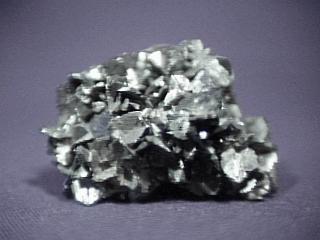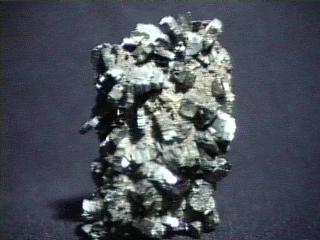
MARCASITE
Specimen mar-1
$ 100.00
Dims: 3-1/2" x 3-1/2" x 2"
Wt: 1 lb., 1 oz
Tri-State Mining Dist., Joplin, Missouri, U.S.A.
Dozens of impressively sized Marcasite "spearhead" or "cockscomb" twins adorn this specimen. The largest crystal measures 3/4" from base to termination and most of the remainder measure between 3/8" and 1/2". There is a substantial amount of damage to certain areas, resulting in spots of crushed Marcasite, but those crystals which are complete have very little damage, if any. Almost every crystal on the specimen is twinned and in a "spearhead" form. This is a very beautiful specimen with quite a lot of Marcasite on it.
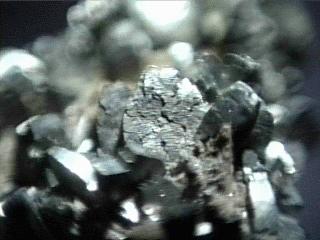
 Amethyst Galleries' Mineral Gallery MINERALS |

MARCASITE specimen mar-1
$ 100.00
$ 100.00
Dims: 3-1/2" x 3-1/2" x 2"
Wt: 1 lb., 1 oz
Tri-State Mining Dist., Joplin, Missouri, U.S.A.
Dozens of impressively sized Marcasite "spearhead" or "cockscomb" twins adorn this specimen. The largest crystal measures 3/4" from base to termination and most of the remainder measure between 3/8" and 1/2". There is a substantial amount of damage to certain areas, resulting in spots of crushed Marcasite, but those crystals which are complete have very little damage, if any. Almost every crystal on the specimen is twinned and in a "spearhead" form. This is a very beautiful specimen with quite a lot of Marcasite on it.


mar-1 ($100.00)
Tri-State Mining Dist., Joplin, Missouri, U.S.A.
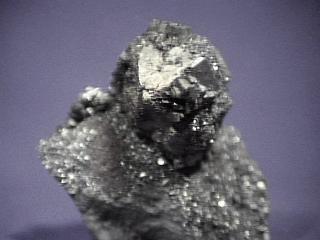
MARCASITE specimen mar-4
$ 98.00
$ 98.00
Dims: 3.0" x 3.1" x 1.6"(7.6 x 7.9 x 4.1 cm)
Wt: 7.43 oz.(210.9 g.)
Rennselear, Indiana, U.S.A.
I think that this is one of the most interesting metallic sulfide specimens that I have yet seen. It contains both Marcasite and pyrite, but their association is anything but ordinary. The pyrite occurrs in a large pyritohedron that measures about 1.3"(3.3 cm) in diameter. The Marcasite occurs as a coating over the pyritohedron that covers at least 80% of its surface; only a small portion of one face of the pyrite crystal is visible. The crust has crystalline tendencies, with misshapen clusters and diamond-shaped prisms projecting outwards. Many tiny crystals also coat the host rock, which appears to be a dark limestone. I have not seen a formation like this before, especially from Indiana!

mar-4 ($ 98.00)
Rennselear, Indiana, U.S.A.
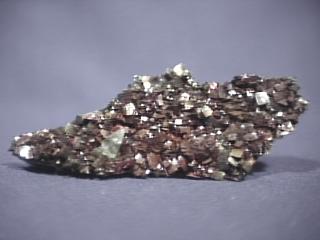
MARCASITE specimen mar-5
$ 25.00
$ 25.00
Dims: 3.9" x 2.0" x 1.7"(9.9 x 5.1 x 4.3 cm)
Wt: 3.77 oz.(107.0 g.)
Czar Drift, Mine #29, Washington County, Missouri, U.S.A.
This specimen consists of a narrow slab of gray limestone that is covered with reddish, tabular Marcasite crystals with a diamond-shaped cross-section. Their form is excellent, and some show evidence of twinning. They reach a maximum size of approximately 0.3" (8 mm) square and have a metallic luster. A single scalenohedral calcite crystal extends out of the cluster at an angle; it measures 0.4" (1.0 cm), has a faint yellow color and vitreous luster, is transparent and clear, and like the Marcasites, shows no damage. These are some very unusual crystals from a locality that I have not heard of before.

mar-5 ($ 25.00)
Czar Drift, Mine #29, Washington County, Missouri, U.S.A.
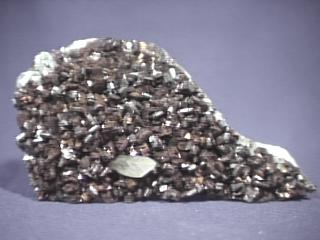
MARCASITE specimen mar-6
$ 65.00
$ 65.00
Dims: 6.1" x 3.9" x 2.4"(15.5 x 9.9 x 6.1 cm)
Wt: 2lbs., 0.9 oz.(932 g.)
Czar Drift, Mine #29, Washington County, Missouri, U.S.A.
A thick chunk of calcitic limestone that is covered with a crust of hundreds of Marcasite crystals makes up this specimen. The Marcasites do not exceed 0.5" (1.3 cm) in any dimension, and occur in both an rectangular tabular form and a prismatic form with a diamond-shaped cross-section. They have the standard metallic luster of the mineral, but have a rather unusual orange-brown, coppery coloration. Along one edge of the crust, one can see the some of the crystals' cross-sections, and the familiar green-yellow coloration. A single calcite scalenohedron juts out of the crust, towering over the Marcasites; it has excellent form, and only a tiny chip cleaved off of its tip. Its color is a pale yellow and it has a pearly luster and dim transparence that is interrupted by internal fractures and cleavage lines. It is a large specimen from a locality that is unknown to me.
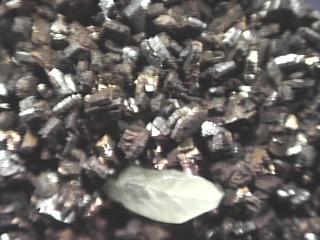

mar-6 ($ 65.00)
Czar Drift, Mine #29, Washington County, Missouri, U.S.A.
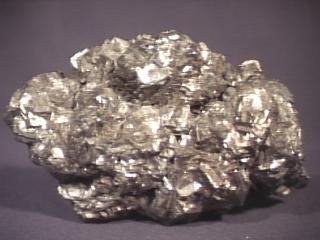
MARCASITE specimen mar-7
$ 125.00
$ 125.00
Dims: 6.0" x 3.5" x 2.2" (15.2 x 8.9 x 5.6 cm)
Wt: 2 lbs., 12.8 oz. (1.271 g.)
Amax Mine, Reynolds County, Missouri, U.S.A.
This massive specimen consists of a formation that is made mostly of intergrown pseudocubic Marcasite crystals. They are generally in excellent condition, showing very little damage. Their form is reasonably good, though individual crystals are difficult to isolate due to the intense intergrowth. However, some do appear to exceed 1" (2.5 cm) along an edge. Their color is a deep, dull gold, and they have a metallic luster that is slightly duller than that of pyrite. The underside of the specimen shows many small, intergrown cubic galena crystals and hundreds of tiny rhombohedral calcite crystals. A small amount of rust-staining on the bottom shows evidence of the breakdown of the Marcasite through its production of sulfuric acid, but it seems to be confined. It is one of the larger Marcasite specimens that we have available.

mar-7 ($125.00)
Amax Mine, Reynolds County, Missouri, U.S.A.
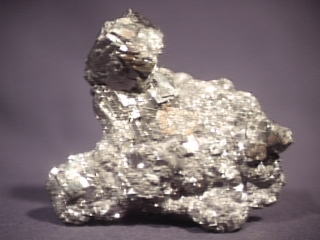
MARCASITE specimen mar-8
$ 20.00
$ 20.00
Dims: 2.9" x 2.8" x 2.0" (7.4 x 7.1 x 5.1 cm)
Wt: 10.33 oz. (292.8 g.)
Amax Mine, Reynolds County, Missouri, U.S.A.
Many pseudocubic Marcasite crystals, ranging in size from 0.1- 0.8" (0.3- 2.0 cm) along an edge, are intergrown to make up this specimen. They have the standard pale gold color and metallic luster of Marcasite, and show relatively good form and little damage. However, a few spots on the piece show the telltale rusty signs of decay that is caused by the freeing of sulfur from the Marcasite, forming Sulfuric acid that in turn attacks the remaining material. The bottom of the piece shows an almost botryoidal appearance; the crystals there are extremely fine, measuring less than 1 mm, and are densely packed. This piece would make a good specimen for the person who is interested in the decay rate of Marcasite, and could be broken up so that one could examine the decay in a variety of environments.

mar-8 ($ 20.00)
Amax Mine, Reynolds County, Missouri, U.S.A.
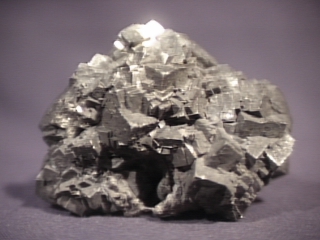
MARCASITE specimen mar-9
$ 24.00
$ 24.00
Dims: 3.4" x 2.5" x 2.4" (8.6 x 6.4 x 6.1 cm)
Wt: 1 lb., 3.6 oz. (557 g.)
Amax Mine, Reynolds County, Missouri, U.S.A.
This specimen from the American midwest consists of a large mass that is made up of many intergrown pseudocubic Marcasite crystals. They range in size from 0.1- 0.7" (0.3- 1.8 cm) along an edge, and have excellent form and only minor damage. There is a small depression in the piece wherein rests some Marcasite that has a noncrystalline form that is rather smooth and rounded, but is not botryoidal or mamillary. All of it has a rather dark golden-gray coloration and a dull, almost submetallic luster. The few damaged areas, however, show a paler gold color and a brighter luster. It is a heavy piece that may be appropriate for a younger collector.


mar-9 ($ 24.00)
Amax Mine, Reynolds County, Missouri, U.S.A.
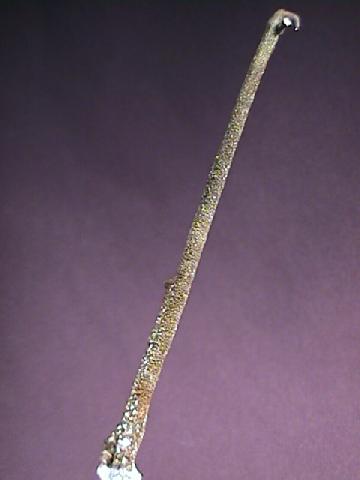
$ 120.00
Dims: 4.6 x 0.2 x 0.2" (11.7 x 0.5 x 0.5 cm)
Wt: 14.0 g w/ base
Cave-In-Rock, Illinois, U.S.A.
Easily the most unusual Marcasite specimen that I have seen from this locality, this specimen consists of a long, thin stalactitic formation that is exceptionally straight for most of its length. I would guess that calcite might make up or have made up the core of this formation, and the Marcasite subsequently coated it. The Marcasite is crystalline, though the crystals do not exceed 3 mm in any dimension. However, they are in excellent condition, as they appear to be undamaged. The visible crystals have an octahedral form, a deep golden color, and a metallic luster. Two other such stalactites intersected with this one, but they are broken, and only small sections remain. The tip of the stalactite is quite unusual, as it curves rapidly just before it terminates; it almost has the shape of the bill of a flamingo (see the close-up image)! There is no host rock present, and the stalactite is attached to a square acrylic base with a hot glue.
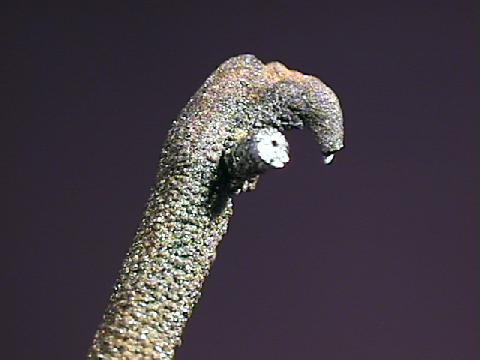

Cave-In-Rock, Illinois, U.S.A.
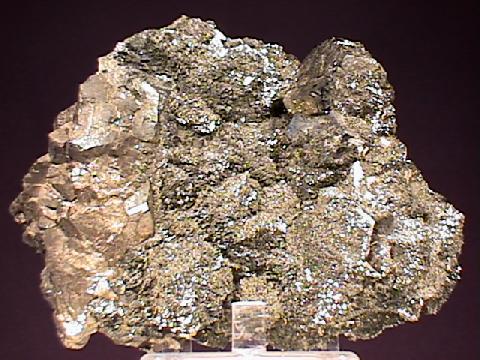
MARCASITE specimen mar-11
$ 55.00
$ 55.00
Dims: 4.8 x 3.9 x 1.9" (12.2 x 9.9 x 4.8 cm)
Wt: 1 lb., 9.6 oz. (727 g)
Amax Mine, Reynolds County, Missouri, U.S.A.
The documentation for this specimen stated that it is made of Marcasite and pyrite, but I believe that pseudomorphing has likely occurred, and that the piece is mostly Marcasite by weight, though I could be wrong. It consists of a thick crust of intergrown "pyrite" pyritohedrons that are covered with a thinner crust of intergrown Marcasite crystals. There are hundreds of these tiny Marcasites, which do not appear to exceed 0.2" (5 mm) in length- actually, most of them do not seem to exceed 0.1" (3 mm). They are generally not very exposed, and so are in excellent condition, showing only a small amount of damage. All have excellent orthorhombic prismatic form, with many of them clustered together in almost "cockscomb" formations. All have a dull, pale golden coloration and the standard metallic luster. The "pyrites" on which they rest also show excellent form, with well-defined edges and clean faces. These crystals range in diameter from 0.2" (5 mm) to 1.0" (2.5 cm) or more, though most are covered with the Marcasite crust. Many are incomplete, likely due to damage incurred during mining. The underside of the specimen shows excellent evidence of the crystalline nature of the crust, with many flat, geometric faces and indentations, as there is no host rock present.

mar-11 ($ 55.00)
Amax Mine, Reynolds County, Missouri, U.S.A.

MARCASITE specimen mar-12
$ 26.00
$ 26.00
Dims: 2.7 x 2.1 x 1.8" (6.9 x 5.3 x 4.6 cm)
Wt: 4.72 oz. (133.7 g)
Reynolds County, Missouri, U.S.A.
The Marcasite that makes up most of the mass of this hand specimen is in excellent condition, showing only minor to moderate damage. Its form is one of its most interesting aspects- it is nearly plumose, and no actual crystals can be defined. All of its formations are rounded and heavily intergrown. It has the standard dark golden coloration and moderately dull luster of Marcasite, and shows no iridescence. Attached to the Marcasite are several galena cubes that appear to be in excellent condition. Their cubic form is very good, and their color and luster are standard for their species. Most of them are overgrown, however, by a cluster of small white dolomite crystals. The dolomites are in remarkably good condition for their softness and exposure, and do not exceed 0.2" (5 mm) in diameter. Their rhombohedral form is very good, and all have a pearly luster and are translucent.

mar-12 ($ 26.00)
Reynolds County, Missouri, U.S.A.
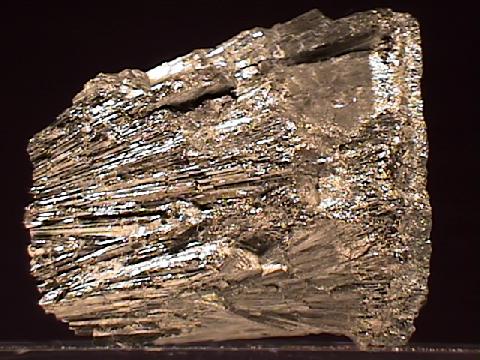
MARCASITE specimen mar-13
$ 25.00
$ 25.00
Dims: 2.0 x 1.3 x 1.0" (5.1 x 3.3 x 2.5 cm)
Wt: 3.00 oz. (85.2 g)
Reynolds County, Missouri, U.S.A.
This specimen appears to consist of a spray of almost needle-like Marcasite crystals, most of which are compact and nearly massive in form. Due to breakage, it is difficult to determine the actual length of any crystal, but some would appear to have been at least 1" in length. Even though all are compacted to a degree, many still show a good orthohrombic prismatic form, with well-defined edges and generally clean faces. All have the pale golden coloration and metallic luster of their species. The specimen is in very good condition, as it has not begun to decay. There is no host rock present- the specimen is made up entirely of Marcasite.

mar-13 ($ 25.00)
Reynolds County, Missouri, U.S.A.
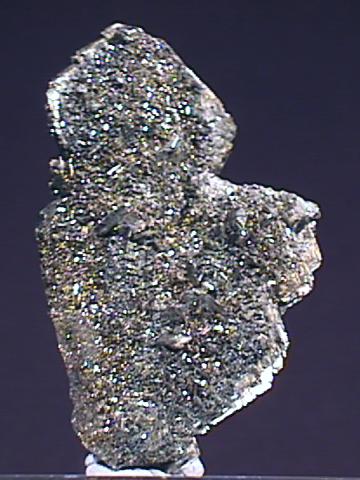
MARCASITE specimen mar-14
$ 25.00
$ 25.00
Dims: 2.3 x 1.4 x 0.7" (5.8 x 3.6 x 1.8 cm)
Wt: 2.40 oz. (68.3 g)
Vintrov, Bohemia, Czech Republic
This small thumbnail specimen consists of two partly intergrown formations that are made entirely out of countless intergrown Marcasite crystals. These tiny crystals congregate around a few very large, apparently tabular Marcasites which reach diameters of 0.9" (2.3 cm). The smaller crystals vary widely in size, but most appear not to exceed 0.1" (3 mm) in diameter. There is a small amount of damage present on the tip of one formation, and the other is broken so that one can see part of its interior- its internal structure looks stalactitic. None of the crystals is completely exposed, but they have good visible orthorhombic tabular form, with well-defined edges. Their color ranges from a dull greenish-blue to a dull golden, and all have the standard metallic luster. A few spots show slight decomposition, but it has not taken serious effect. There is no host rock present.

mar-14 ($ 25.00)
Vintrov, Bohemia, Czech Republic
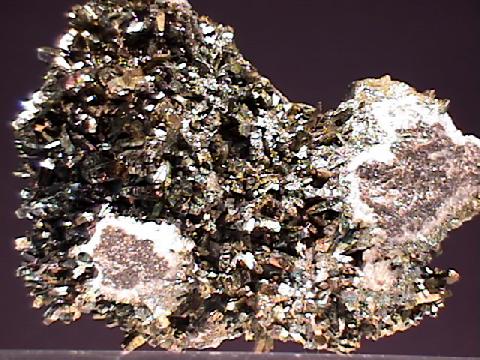
MARCASITE specimen mar-15
$ 30.00
$ 30.00
Dims: 2.7 x 2.2 x 1.6" (6.9 x 5.6 x 4.1 cm)
Wt: 5.80 oz. (164.6 g)
Reynolds County, Missouri, U.S.A.
The gray limestone base of this hand specimen is mostly covered by hundreds of small Marcasite crystals. Though noticeable damage or breakage is present, most of these crystals are intact and in excellent condition. All have good orthorhombic prismatic form, and show the "cockscomb" formations that are a hallmark of this mineral (see the second image). These formations have well-defined edges and clean faces. All have the standard metallic luster of Marcasite and show colors that vary from a deep gold to a blue-green. The formations do not tend to exceed 0.4" (1.0 cm) in height, 0.7" (1.8 cm) in width, or 0.2" (5 mm) in thickness. Much of this Marcasite crust rests on crusts of small white dolomite crystals which in turn coat the gray base rock.
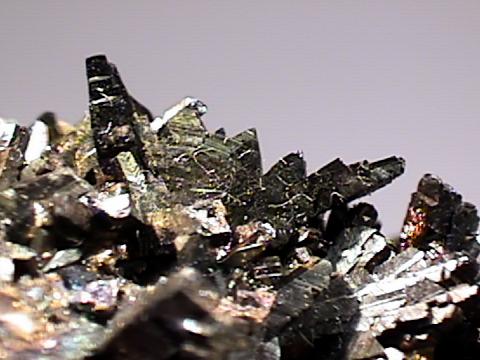

mar-15 ($ 30.00)
Reynolds County, Missouri, U.S.A.
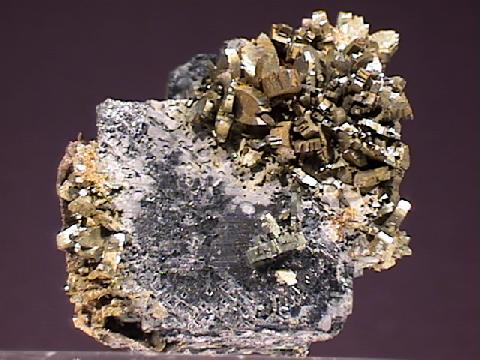
MARCASITE specimen mar-16
$ 64.00
$ 64.00
Dims: 2.5 x 1.7 x 1.7" (6.4 x 4.3 x 4.3 cm)
Wt: 9.24 oz. (261.9 g)
Joplin, Missouri, U.S.A.
Several clusters of intergrown Marcasite crystals rest on the crystalline galena base of this specimen. Though one cluster is heavily damaged and broken, the rest of the Marcasites are intact and in excellent condition. All have good orthorhombic prismatic form and the "cockscomb" habit that is a hallmark of this mineral. Their color is likewise the standard dull gold and their luster is metallic but slightly dull. Most appear to be slightly rust-stained, probably due to weathering. The galena base on which they rest is made up of one large and rather well-formed cube that shows moderate damage, a dark silvery-gray color and a rather bright metallic luster. There is no other matrerial present.
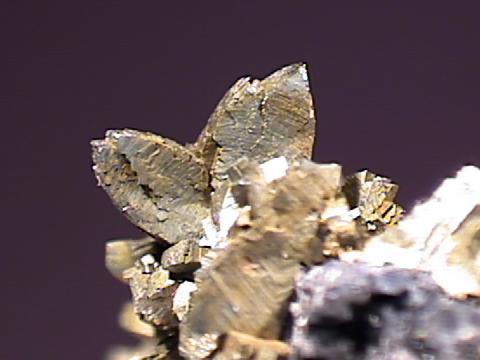

mar-16 ($ 64.00)
Joplin, Missouri, U.S.A.
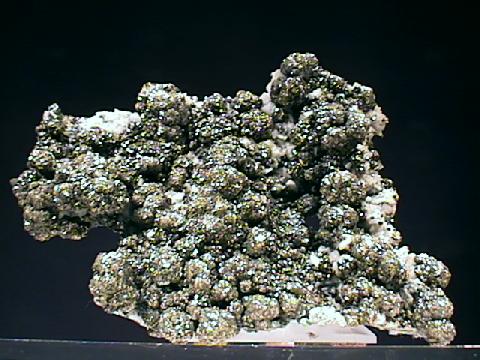
MARCASITE specimen mar-17
$ 26.00
$ 26.00
Dims: 5.2 x 3.6 x 1.2" (13.2 x 9.1 x 3.0 cm)
Wt: 8.90 oz. (252.3 g)
Reynolds County, Missouri, U.S.A.
Many rounded clusters of Marcasite crystals coat the thin, flat base of this hand specimen. These clusters measure up to 0.5" (1.3 cm) in diameter, are generally in very good condition, and are heavily intergrown with each other. The crystals that form each cluster are likewise heavily intergrown, and thus their orthorhombic forms are very difficult to study. All have the standard dark, dull golden coloration and dull metallic luster of their species. They rest atop crusts of small white dolomite crystals that coat the gray dolomitic limestone base rock. There also appear to be several very tiny chalcopyrite crystals present, most of which rest on the visible dolomite crust.

mar-17 ($ 26.00)
Reynolds County, Missouri, U.S.A.

MARCASITE specimen mar-18
$ 25.00
$ 25.00
Dims: 2.7 x 2.4 x 1.0" (6.8 x 6.0 x 2.5 cm)
Wt: 5.27 oz. (149.5 g)
Amax Mine, Reynolds County, Missouri, U.S.A.
This hand specimen consists of a crust of crystalline and semicrystalline Marcasite. It is in good condition, showing only the breakage on the edges of the piece, and is generally about 0.5 - 0.6" (1.3 - 1.5 cm) thick. The Marcasite actually takes on two different habits- most of the material has a deep golden coloration and shows a compact, almost fibrous habit; this material is covered with a thin layer of blue-green Marcasite that has a more tabular, platy habit. Both varieties show a metallic luster, though the luster of the tabular material is slightly duller. The underside of the crust is covered with what appears to be a thin layer of gray-brown limestone.

mar-18 ($ 25.00)
Amax Mine, Reynolds County, Missouri, U.S.A.
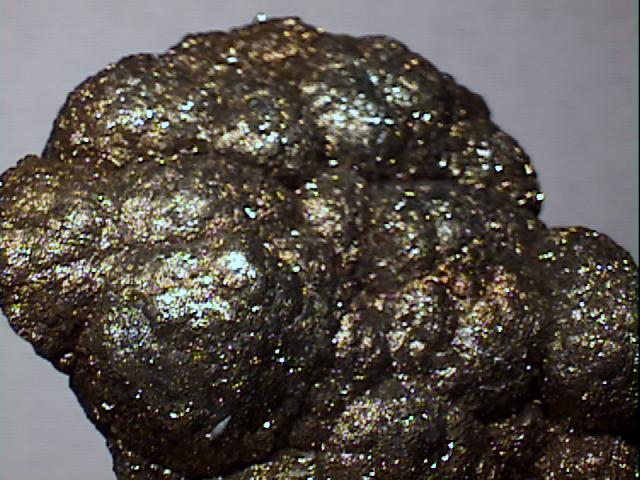
MARCASITE specimen mar-19
$ 43.00
$ 43.00
Dims: 2.79x2.22x0.98" (7.07x5.63x2.50cm)
Wt: 7.42oz (210g)
Lubin, Poland
This marcasite specimen is rather appealing, in that is has rounded, mammilary clusters with a brassy color and with irridescent hues of red and blue. Under a loupe, the sparkly mounds resolve into millions of tiny cubes whose faces are rounded and largely aligned with the surface. The overall effect is a rounded, sparkly surface that looks silvery, brassy, or even coppery depending upon the angle the light strikes it.


mar-19 ($ 43.00)
Lubin, Poland
